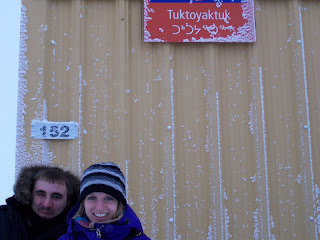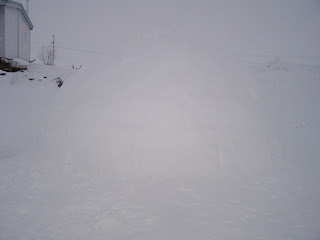
Well after weeks of little time to sit down and write on the blog post here I return with a shortie but with many photos, as they Like a vague sleeve you do not want to read.
turns out that since mid-December ice opened the route that connects Inuvik to Tucktoyaktuk which is another native community still further north to Inuvik, but which can only be reached by driving through the winter. When the Mackenzie River freezes enough to handle. When they open the route is relatively safe although it is better to wait a couple more weeks to be safe and that's what we did we waited until mid-January to go visit the nearby community.
PleaseMo's van and we went there. Phil, Jordan, Louise, and I Pinette. I driver, never seen a Uruguayan driving on ice route, much less a danger behind the wheel as I jijijiji. So after stack all the arctic jackets for girls are nothing more than the Backpacks more food for lunch and we thought spending the day in Tuk (as affectionately call this community), we fasten our seatbelts and exit. Some 200 km away but as none of us had much idea of \u200b\u200bwhat conditions were the route I decided not exceed 60/70 km / h in case. So after about 3 hours driving in the dark since that time there were only about 20 minutes of sun per day and 5 hours of clarity we Tuk.
Ice Route
Reaching
Tuk
The 5 brave (Phill, Louise, Pinette, Me and Jordan)
is a very small town, about 900 people live there year round. There are two supermarkets, a small school and not much else.
Dog in the Arctic, the best picture to describe the loneliness of the place ...
Omnibus in Tuk (oh so it seemed)
Louise Jordan and Tuk
Phill in Tuk
Yo Tuk
As good tourists we are, we went to the route marker trans Canada as it is the northernmost point that reaches the route. And from there we went to walk around the Arctic Ocean. Although it had to be careful because some cracks are very deep but they were covered with snow capita than invisible to the naked eye. I messed up when I was back in for a picture. But no one was hurt.
Phil, Louise, Jordan and Pinette on the scoreboard but the route north of Trans Canada
Finding cracks in the frozen ocean jijij
After Louise and I decided we'd go swimming in the Arctic, so it was that the trip was organized at the beginning, we started to walk out to sea But after about 200 or 300 meters, we gave up and we were not going to find water for several tens of kilometers at least, and not, was not to make a hole first because we had to do and secondly because there must be at at least a couple of feet of ice on the surface. But we were not Tuk go without trying at least so in a fit of madness, we stayed in mesh and short respectively bathroom and pretend we were floating in the water or sunbathing. Same all lasted less than a minute because we had to dress quickie to die of cold not, maybe in the summer I can dip into other ocean more.
Phil, Louise, Pinette and Jordan sitting in the port of Tuk
We reached the Arctic ocean
water
well here we go swimming
no water but happy to be there
After our walk through the waters of the Arctic Ocean, went to the city where we walked almost every street, you see in the pictures the houses suffer from constant lashing wind and conditions are pretty brutal, that day was about 40 degrees below zero, we found the remains of the first 2 Tuk buildings, which are a kind of huts, also visited the boat they used for years to transport children to school. We walked on a pingo, which is a unique formation of the Arctic and Tuk area is the richest in these formations, basically are a kind of ice volcano but no lava. The tectonic plates forced the frozen layers of soil and create small holes in the middle hills, but over time the wind and the snow so eroded leaving no visible opening round.
From the top of the pingo
Some pingos that are near Tuk
Buildings Tuk oldest
So are all the houses in Tuk, ice and snow covered
Barco, Our Lady of Lourdes
freezer also visited the Village, if you happen by 1930 decided to create a freezer for the summer to which I dig a hole in the ground to reach the layers that never melted and created a series of tunnels and chambers where people could put meat in the summer so that insects do not ruin or take to lose. The constant temperature is 20 degrees below zero and the truth that when we entered the freezer felt like a comfortable temperature as they were 20 degrees hotter than outside and there was no wind. Is reached via a staircase that descends about 10 feet to the layer of ice and sand which is the basis of this area and also the reason why all the buildings have no foundations and that the movements of the different strata ice and sand are constant. And there will be 3 tunnels of about 1.20 meters high and 1 meter wide. And these tunnels are no doors to enter the small chambers where people can put their meat and lock the door for safety. The woman who allowed us access to the freezer told us today is very few people still used because it is easier to have a conventional freezer at home or put it in a galponcito in the back of the house during the winter. So many doors were open and empty chambers, but we found a camera that had what looked like a seal skin and frozen geese. But most wonderful of all were the crystals that covered the ceiling of the chambers of the tunnel, we were enthralled by them and not get tired of taking pictures of them but I do not think we captivated the wonder of the show in the pictures ...
The entrance to the freezer
Lowering the freezer
We're all (Pinette, Louise, Phill)
The Tunnels


After the visit in the Freezer, we picked one that had igloos done the day before the festival welcoming the sun. Which if I may say it was not easy because the igloos were covered with snow and the white background of the frozen ocean is difficult to locate but we found one and we got the truth that while it is an ice house, again to be protected from the wind felt the difference in temperature and the small opening is the door creates a kind of camera you maintain an average temperature. The truth that looked very nice as in the joints of the blocks of ice you could see the light of day and gave a very charming, but really do not know if an igloo home.
The igloo, seen from outside
in the IgluI
Jordan, Phill, Pinette, Louise in the Iglu
I
Jordan out of Iglu
out of the iglu Phill
Louise out of Iglu
Iglu of
Before we went back to the supermarket, where we ask to use the bathroom and we were amazed with the prices of food, which explains the continuing exodus of people from Tuk to Inuvik in winter to buy food at the super in Inuvik and that food is not very cheap to say.
The images speak for themselves
With $ 30 in fruit on the hands ....
And ta, that's the end Tuk, fue un gran día y con más confianza al regresar manejando a 100 km/h regresamos en un poco más de dos horas pero todos sanos y salvos y muy contentos con la experiencia.
Ahora estamos esperando unos días más para ir a Aklavik, otra comunidad que está a mitad de camino entre Inuvik y Tuk, que es más pequeña aun pero que esta al pie de las montañas así que las vistas del delta deben de ser muy lindas, pero para eso habrá que esperar.
Gracias por leer
Juan













































 I and Pinette
I and Pinette 













